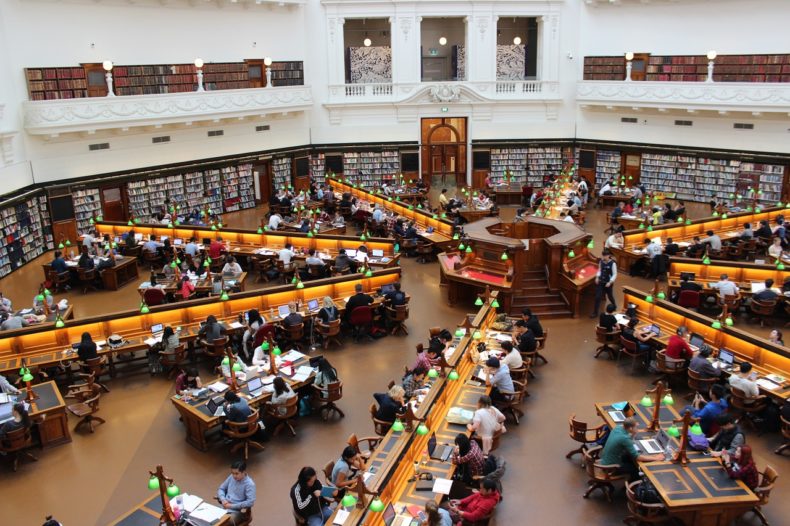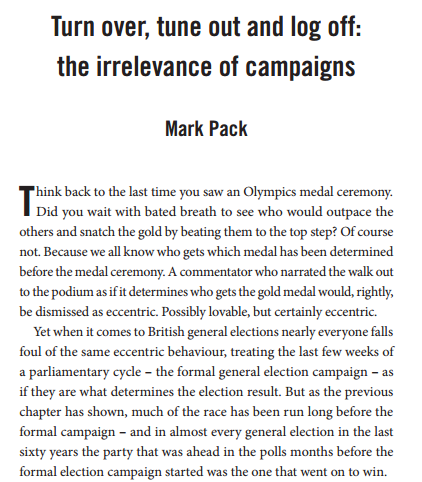6 stories political scientists aren’t researching about the election

I originally wrote this piece about the 2015 general election, and alaos what was not being researched in 2015 is still not being researched in 2017. So here it is again, containing the same six stories although with the details updated for the passage of two years.
One of the reasons behind the 6 stories the media didn’t write about the 2015 general election is that even excellent journalists are often so busy, and stretched across so many areas, that it is very hard for them to find the time to do anything more than simply report in some way stories that others serve up to them. One of Britain’s best political journalists made this point powerfully to me when we were discussing this issue a few years ago by simply reeling of the topics he had needed to cover in his job in the previous few days. Since then, the financial pressures on journalist numbers have become all the greater – with people therfeore stretched even more to cover more topics and produce more output.
That’s one of the reasons why, for example, the framing of stories about the state of our democracy is so relentlessly negative; there’s no organisation putting out press releases celebrating the sort of good news that I’ve highlighted in my posts about the Campaign for Democratic Optimism – a tongue-in-cheek suggestion but also a serious point in that the absence of such an organisation means that most of the time journalists only get news releases hitting their inbox with negative slants to them.
There is, however, one group that could be serving up a wider range of information to journalists: political scientists. Yet as with journalists, there’s a huge swathe of stories they could – and should – be researching, but instead miss out on because the profession huddles so closely around a relatively small island of knowledge.
Think that’s a bit unfair on the state of political science? Well, consider these six topics that political scientists aren’t researching, yet all of which are central to how our elections work and are covered.
1. Are politicians idiots when it comes to choosing when to spend money?
Comparing opinion polls several months out from polling day with the results for general elections over the last fifty years shows that the lead almost never changes between parties. As I wrote for More Sex, Lies and the Ballot Box:

Yet although elections look to be most settled well before a campaign starts, it is in those last few months that parties spend millions of pounds on campaigning. For smaller parties, this makes sense as their level of support in the relatively small number of constituencies that most concern them can move radically. But for larger parties the picture is consistent: the person in the lead well in advance goes on to win.
So is all this money effective but parties usually fight themselves to a score draw – or is it that the millions of pounds spent in the last few weeks would be far better spent on longer-term campaigning to shift the overall reputation and image of parties and/or on extra policy support to get the big moments right over the course of a Parliament?
2. Does it matter where a party leader goes?
There are two regular features of British election campaigns. First, party leaders go on tours of carefully selected constituencies around the country and, second, parties play a game of briefing and bluff with the media over exactly which seats they really are or aren’t targeting. Deconstructing party leader itineraries can give a valuable insight into campaign strategies, but they are primarily meant to be about winning votes.
Which raises two questions in turn: does a visit from a party leader boost their party in that constituency (either directly through coverage of the visit or indirectly through volunteer motivation and signalling to the electorate of the party’s commitment to the seat) – and can journalists really decode the spin over targeting strategies by instead tracking where leaders actually visit?
It may be more fun poking fun at the photographs taken of party leaders, but wouldn’t some hard data be rather better both for academics and the media? So far, there’s one piece of research on visits and votes, looking at just the one 2010 election – and hence leaving a lot of questions unclear, such as whether the difference between Labour and other parties is about Labour or about being in government. Moreover, it doesn’t address the deconstructing spin side of the topic for which we have just one tweeter to contribute to our knowledge.
3. The death of local constituency expense limits – and how that’s killing political science’s statistical models
I’ve written at some length on the way local expense limits are collapsing in Constituency expense limits are dying off in the UK, but neither politicians nor the regulator will act. Given the recent Conservative Party troubles with constituency limits (short version – the Electoral Commission decided spending was wrongly excluded from constituency expense returns by the Conservatives in 2015 but the CPS decided this was not grounds for prosecuting individuals), it is worth emphasising this is not an issue primarily about law-breaking. Even if everyone keeps 100% within the law, the amount of spending declared on constituency expense returns can be only a very small portion of the total expenditure a party makes in that seat during an election campaign.
In itself, that should be worthy of research, but it’s also potentially a huge headache for political scientists as the death of local limits could also pull the foundations out from under the statistical modelling which dominates a large part of current political science around British elections.
The problem is that the statistical models use declared local expenditure as a proxy for party campaign effort in constituencies – and hence the models can allow for varying levels of local campaigning effort both when trying to explain outcomes and also when trying to isolate the impact of other factors. However the death of local expense limits means that this source of data is increasingly unreliable as a proxy. If local limits no longer mean much, it’s not just elections that are affected. Much other political science research finds itself on very shaky foundations.
The shaky foundations have one prop – there is a good correlation between declared constituency expenditure and recalled campaign contact in the British Election Survey research. However, the latter measure only counts a yes/no – such as, did you receive a leaflet from party X? – rather than the level of contact a voter received. A party which delivers one leaflet to everyone is not distinguished from a party which delivers 20.
Now, people’s recall is not perfect and not every leaflet is seen by everyone behind that letterbox, so there may well be a higher percentage who say they recall receiving at least one leaflet if they actually received 20 rather than one. But even then that makes it a measure that will fail at the top end as the measure has to plateau as it approaches 100%, failing to capture the full impact of extra leaflets going out. Those measures also do not cover fully the increasingly popular range of campaign activities such as sponsored Facebook posts. (For more on this see The danger in the latest British Election Study data).
That is a fragile basis for so much political science research to rest on. Indeed, Alia Middleton’s research on leaders’ visit is a good example of this fragility for as the article says, “To isolate the effect that leader visits have upon the dependent variable, other campaigning in the constituency needs to be controlled for. Measures for each party of the percentage of the legal maximum permitted spent, which offer a rough approximation of other campaigning in the constituency, were entered to control for this. Not only are these campaign expenditure data available for all constituencies, they represent an easily accessible and efficient proxy for campaigning (see for example: Pattie et al. 1995).”
That “1995” should send off warning bells aplenty to the discerning academic because it’s before the major overhaul of party election expenditure controls in 2000 – and which kicked off the death of local party expense limits. To assume that something is a good proxy because of research that was done before a major overhaul of how the system works is, shall we say, brave.
4. Incumbency or organisation? What is it that really makes some politicians more popular?
For a good few decades now, academics have shed the previous conventional wisdom that individual MPs can’t have much of an impact on the election result in their own constituencies. Now it’s widely accepted that there are huge variations. But what really causes those variations?
What’s usually given a single label of “incumbency” or “personal vote” is really two factors: personal popularity and local organisation. If an MP does particularly well is it because of their personal positive attributes or is it because they have a better campaign organisation – or both? How does a bland candidate with an excellent organisation compare with a brilliant candidate who has many reasons to be popular but who doesn’t have an organisation to communicate much?
And what has the decline of local newspapers along the rise of the internet done to this? Have the benefits of incumbency been harmed by the decline of local newspapers as there’s less opportunity for the public to find out that they should like their MP? Has the rise of the internet given MPs the ability to be popular even without local organisation?
Plenty of questions, very little data. So far.
5. Financial self-interesting and misreporting of polls: does the media have a conflict of interest?
It is a frequently made observation that coverage of political opinion polls is often poor, with movements within the margin of error trumpeted as major shifts and with individual polls treated as solid stories rather than risky single points of data.
Yet there’s also potentially a serious financial conflict of interest at work. If media outlets pay for their own polls, does that then pressurise them into making the poll results sound more dramatic than justified because of the need to show that spending money on the poll was worthwhile? Are media outlets worse at reporting their own polls than those paid for by others?
It’s hard to think of another area of such obvious risk of a financial conflict of interest getting so little attention. Step forward then the gallant academics to remedy that.
6. How data protection rules shape campaign tactics
Occasionally a reference to differences in data protection rules between the UK and the US slips into pieces looking at digital campaigning, but only occasionally. Moreover the frame of reference is almost always simply US vs UK. Yet political scientists love multi-country comparative studies. The significant variations in data protection rules, even within the EU (despite the common standards set at the European level), should be a fruitful territory for research – and would answer the question of whether looking only at electoral rules when analysing the functioning of elections is missing a key regulatory factor. If it is, then that’s an important finding – as these sorts of non-electoral regulations almost never get mentioned when election regulations are dissected, discussed or reformed.
Over to you, political science.
Many thanks for bringing this to my notice.
Major problems for democratic representation here, say I, stating the obvious.
David Kirby.